Reading Greek GRAMMAR AND EXERCISES SECOND EDITION First published in 1978, Reading Greek has become a best-selling one-year introductory course in ancient Greek for students and adults. It combines the best of modern and traditional language-learning techniques and is used widely in schools, summer schools and universities across the world. It has also been translated into several foreign languages. This volume provides full grammatical support together with numerous exercises at different levels. For the second edition the presentations of grammar have been substantially rewritten to meet the needs of todays students and the volume has been completely redesigned, with the use of colour. GreekEnglish and EnglishGreek vocabularies are provided, as well as a substantial reference grammar and language surveys.
The accompanying Text and Vocabulary volume contains a narrative adapted entirely from ancient authors in order to encourage students rapidly to develop their reading skills, while simultaneously receiving a good introduction to Greek culture. the joint association of classical teachers greek course THE JOINT ASSOCIATION OF CLASSICAL TEACHERS GREEK COURSE Reading Greek GRAMMAR AND EXERCISES SECOND EDITION  CAMBRIDGE UNIVERSITY PRESS Cambridge, New York, Melbourne, Madrid, Cape Town, Singapore, So Paulo Delhi, Mexico City Cambridge University Press The Edinburgh Building, Cambridge CB2 8RU, UK Published in the United States of America by Cambridge University Press, New York www.cambridge.org Information on this title: www.cambridge.org/9780521698528 The Joint Association of Classical Teachers Greek Course 1978, 2007 This book is in copyright. Subject to statutory exception and to the provisions of relevant collective licensing agreements, no reproduction of any part may take place without the written permission of Cambridge University Press. First edition published 1978 Twenty-sixth reprint 2006 Second edition published 2007 7th printing 2012 Printed in the United Kingdom at the University Press, Cambridge A catalogue record for this publication is available from the British Library ISBN 978-0-521-69852-8 Paperback Cambridge University Press has no responsibility for the persistence or accuracy of URLs for external or third-party internet websites referred to in this publication and does not guarantee that any content on such, websites is, or will remain, accurate or appropriate.
CAMBRIDGE UNIVERSITY PRESS Cambridge, New York, Melbourne, Madrid, Cape Town, Singapore, So Paulo Delhi, Mexico City Cambridge University Press The Edinburgh Building, Cambridge CB2 8RU, UK Published in the United States of America by Cambridge University Press, New York www.cambridge.org Information on this title: www.cambridge.org/9780521698528 The Joint Association of Classical Teachers Greek Course 1978, 2007 This book is in copyright. Subject to statutory exception and to the provisions of relevant collective licensing agreements, no reproduction of any part may take place without the written permission of Cambridge University Press. First edition published 1978 Twenty-sixth reprint 2006 Second edition published 2007 7th printing 2012 Printed in the United Kingdom at the University Press, Cambridge A catalogue record for this publication is available from the British Library ISBN 978-0-521-69852-8 Paperback Cambridge University Press has no responsibility for the persistence or accuracy of URLs for external or third-party internet websites referred to in this publication and does not guarantee that any content on such, websites is, or will remain, accurate or appropriate.  Menander Preface This book is written to be used in step with Reading Greek (Text) of the Joint Association of Classical Teachers Greek Course. 1368). 1368).
Menander Preface This book is written to be used in step with Reading Greek (Text) of the Joint Association of Classical Teachers Greek Course. 1368). 1368).
While we recommend that the Text is tackled before students turn to the grammar and exercises, no harm will be done by taking a different view. B: A Reference Grammar, which summarises and sometimes expands upon the essential features of the grammar met in the Course (pp. 369464). C: A number of Language Surveys which look in detail at some of the more important features of the language (pp. 465496). 497520). 497520).
E: A vocabulary for the English-Greek exercises (pp. 521528). F: Indices to the grammar and to Greek words (pp. 529543), originally constructed by Professor W. K. Lacey and his students at the University of Auckland, New Zealand and here revised.
It would be impracticable to produce an exhaustive grammar of the whole Greek language. We have therefore concentrated attention on its most common features. Students and teachers should bear in mind that the first aim of this grammar is to help students to translate from Greek into English. Peter Jones Newcastle on Tyne October 2006 Acknowledgements to the original edition of Reading Greek (1978) Reading Greek was developed by a Project Team (Dr P.V. Jones, Dr K.C. Sidwell and Miss F.E.
Corrie) under the guidance of a Steering Committee and Advisory Panel made up as follows: Steering Committee: Professor J.P.A. Gould (Bristol University) (Chairman); M.G. Balme (Harrow School); R.M. Griffin (Manchester Grammar School); Dr J.T. Killen (Joint Treasurer, Jesus College, Cambridge); Sir Desmond Lee (Joint Treasurer, President, Hughes Hall, Cambridge); A.C.F. Verity (Headmaster, Leeds Grammar School); Miss E.P.
Story (Hughes Hall, Cambridge). Advisory Panel: G.L. Cawkwell (University College, Oxford); Dr J. Chadwick (Downing College, Cambridge); Professor A. Morpurgo Davies (Somerville College, Oxford); Sir Kenneth Dover (President, Corpus Christi College, Oxford); Professor E.W. Handley (University College, London); B.W.
Kay (HMI); Dr A.H. Sommerstein (Nottingham University); Dr B. Sparkes (Southampton University); G. Suggitt (Headmaster, Stratton School); A.F. Turberfield (HMI). Grammar: J.C.; A.M.D.; A.H.S. (who, with K.J.D., have kindly made individual contributions to the Reference Grammar and Language Surveys). Exercises: M.G.B.; R.M.G.; A.C.F.V. Background: G.L.C.; J.P.A.G.; B.S. Dissemination: B.W.K.; H.D.P.L.; E.P.S.; G.S.; A.F.T. Dissemination: B.W.K.; H.D.P.L.; E.P.S.; G.S.; A.F.T.
We have also been guided by a number of overseas scholars who have used, or given advice on, the Course, as follows: J.A. Barsby (Dunedin, New Zealand); S. Ebbesen (Copenhagen, Denmark); B. Gollan (Queensland, Australia); Professor A.S. Henry (Monash, Australia); Drs D. Sieswerda (Holland); Professor H.A.
Thompson (Princeton, U.S.A.). We would like to stress the immense debt of gratitude which we all owe to the Steering Committee, Advisory Panel and our overseas advisers. But we would also like to make it clear that the final decisions about every aspect of the Course and any errors of omission and commission are the sole responsibility of the Team. We gratefully acknowledge the help and advice of Professor D. W. Packard (Chapel Hill, N.
Carolina, U.S.A.) on the use of the computer in analysing and printing Greek; and of Dr John Dawson of the Cambridge University Literary and Linguistic Computing Laboratory, who made available to us the resources of the Computer Centre for printing and analysing draft material in the early stages of the Project. We have learnt a great deal from members of the Team who produced the Cambridge Latin Course, and are extremely grateful to them for help, especially in the early stages of the Project. If we have produced a Course which takes a more traditional view of language-learning, our debt to many of the principles and much of the practice which the C.L.C. first advocated is still very great. Finally, our best thanks go to all the teachers in schools, universities and adult education centres both in the U.K. and overseas who used and criticised draft materials.
We owe an especial debt of thanks to the organisers of the J.A.C.T. Greek Summer School in Cheltenham, who allowed us to use our material at the School for the three years while the Course was being developed. Peter V. Jones (Director) Keith C. Sidwell (Second Writer) Frances E. Tempora mutantur it has now been revised on the assumption that they do not, and in the light of the experiences of those using the course over nearly thirty years. Tempora mutantur it has now been revised on the assumption that they do not, and in the light of the experiences of those using the course over nearly thirty years.
While the overall structure of the course and its reading matter remain the same, the most important changes are: Text 1. The running and learning vocabularies are now in the Text, on the same pages as the Greek to which they refer. The Text
Next page
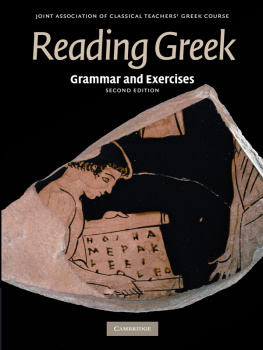


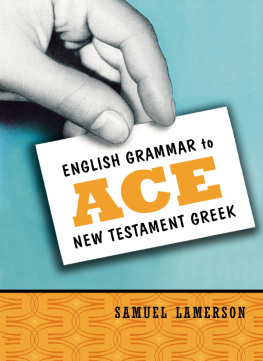
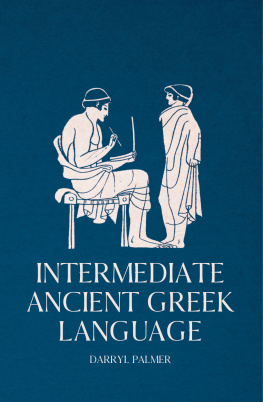
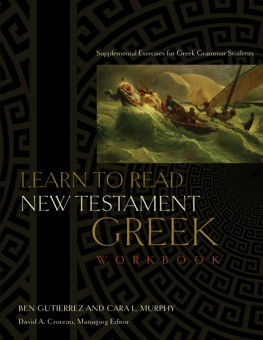
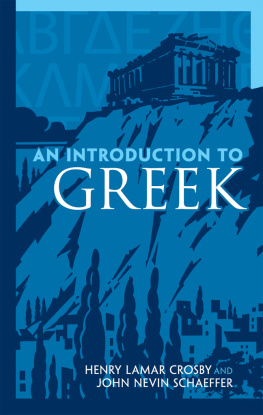
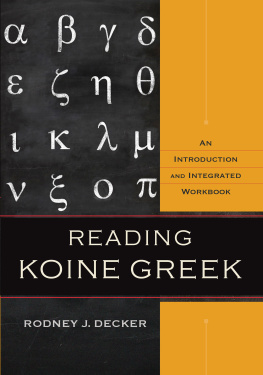
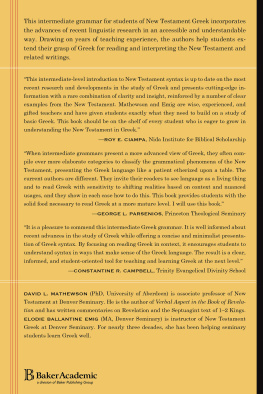
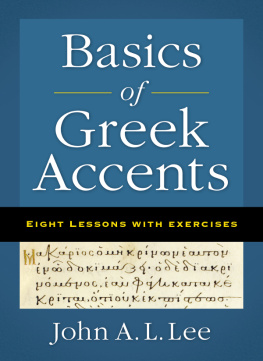
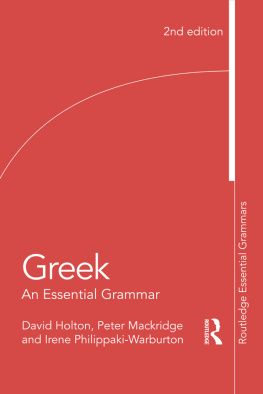
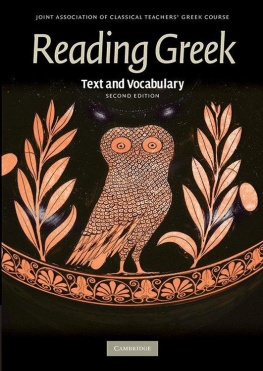

 CAMBRIDGE UNIVERSITY PRESS Cambridge, New York, Melbourne, Madrid, Cape Town, Singapore, So Paulo Delhi, Mexico City Cambridge University Press The Edinburgh Building, Cambridge CB2 8RU, UK Published in the United States of America by Cambridge University Press, New York www.cambridge.org Information on this title: www.cambridge.org/9780521698528 The Joint Association of Classical Teachers Greek Course 1978, 2007 This book is in copyright. Subject to statutory exception and to the provisions of relevant collective licensing agreements, no reproduction of any part may take place without the written permission of Cambridge University Press. First edition published 1978 Twenty-sixth reprint 2006 Second edition published 2007 7th printing 2012 Printed in the United Kingdom at the University Press, Cambridge A catalogue record for this publication is available from the British Library ISBN 978-0-521-69852-8 Paperback Cambridge University Press has no responsibility for the persistence or accuracy of URLs for external or third-party internet websites referred to in this publication and does not guarantee that any content on such, websites is, or will remain, accurate or appropriate.
CAMBRIDGE UNIVERSITY PRESS Cambridge, New York, Melbourne, Madrid, Cape Town, Singapore, So Paulo Delhi, Mexico City Cambridge University Press The Edinburgh Building, Cambridge CB2 8RU, UK Published in the United States of America by Cambridge University Press, New York www.cambridge.org Information on this title: www.cambridge.org/9780521698528 The Joint Association of Classical Teachers Greek Course 1978, 2007 This book is in copyright. Subject to statutory exception and to the provisions of relevant collective licensing agreements, no reproduction of any part may take place without the written permission of Cambridge University Press. First edition published 1978 Twenty-sixth reprint 2006 Second edition published 2007 7th printing 2012 Printed in the United Kingdom at the University Press, Cambridge A catalogue record for this publication is available from the British Library ISBN 978-0-521-69852-8 Paperback Cambridge University Press has no responsibility for the persistence or accuracy of URLs for external or third-party internet websites referred to in this publication and does not guarantee that any content on such, websites is, or will remain, accurate or appropriate.  Menander Preface This book is written to be used in step with Reading Greek (Text) of the Joint Association of Classical Teachers Greek Course. 1368). 1368).
Menander Preface This book is written to be used in step with Reading Greek (Text) of the Joint Association of Classical Teachers Greek Course. 1368). 1368).